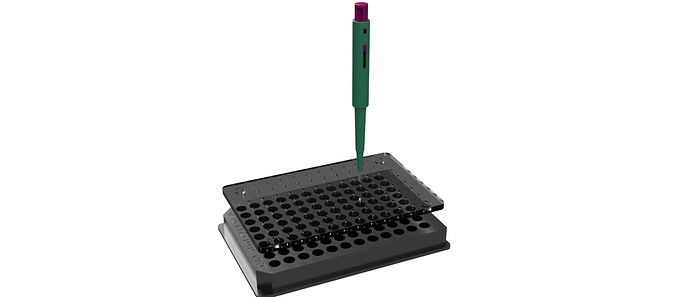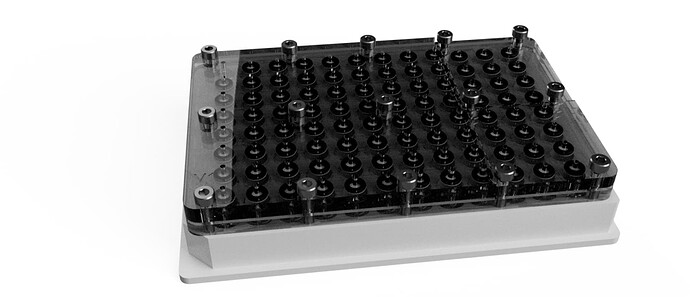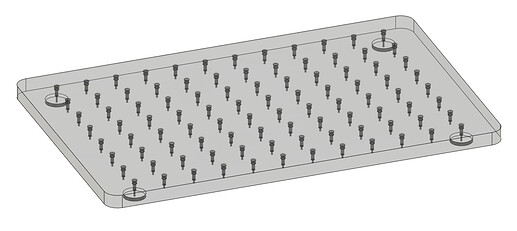This is a project from work that I thought I would share as my Nomad 883 Pro has lived there for the last few years. This is a project where I was helping researchers working with mass spectrometry for small biological samples.
Mass spectrometry is a common tool used in academia to for example look at what proteins are found in biological samples. This type of data can be useful for many scientific questions like understanding what proteins/molecules are important for certain tissues/processes etc. The preparation of a sample to be injected into a mass spectrometer involves some washing steps, and for proteins also cutting them into small bits (enzymatic digestion). This sample preparation is usually done on filter membranes (preparing samples on filter membranes increases the efficiency of some of the treatments, it is a little unclear why but it has been demonstrated by lots of people). A liquid sample is pipetted onto a filter membrane and centrifuged so it goes into the filter and gets stuck, then the sample preparation can be done on the filter and the sample can be eluted from the filter when ready to analyze. For most biomedical assays there are commercial kits available to purchase, the issue this project faced was that they wanted to look at very small samples and all commercial filter kits had too large filter surface areas (about 6 diameter, 30 mm2 ish) that resulted in much of the sample being lost due to inefficiencies in getting the sample out of the membrane (I guess all process have losses at each step and for this assay it meant the commercial kits were not very useful). Therefore, they wanted a filter system with very small filter surface areas as to not loose much of the sample.
The first prototype to create these small filter systems was a polycarbonate sandwich with 96 mounting positions for filters and O-rings that one would assemble on top of cut filters on one polycarbonate plate. The O-rings would be clamped with another polycarbonate plate using screws. The O-rings created “wells” that liquid samples could be pipetted into and then the entire sandwich would be centrifuged to immobilize the sample in the filters. The bottom polycarbonate plate had groves for mounting cut filters and O-rings and on the other side locating features to mount on top of commercial 96 well plates which are commonly used in biomedical labs, so that part was a double-sided machining job. Dowel pins was used to relocate the polycarbonate part after flipping it over. The purpose of having the plate mount onto 96 well plates was so the samples could be separated and collected after elution from the filters. This prototype was a terrible idea due to 1: it was a mess to assemble 96 O-rings with a diameter of 3.5 mm and 2: the surface area of the filters were still too large.
The final version was a single machined polycarbonate plate that had 96 filter mounting positions with locating features on the bottom side to mount onto a 96-well plates. A biopsy punch was used to cut out 1 mm diameter filter membranes (0.785 mm2) that were mounted in the plate. The filter mounting positions had a shallow counterbore that was used to align a biopsy punch (with a filter in its bore) and allowed assemble of the filter into a deeper counterbore by pushing out the filter out of the biopsy punch. The filters would be press-fitted into the deeper counterbore and seal against the polycarbonate. The liquid sample can be pipetted into the milled “wells/filter mounting positions” and centrifuged into the filters. After treatment the samples can be eluted from the filters into 96 well plates. This method, together with the process optimization for washing steps etc was recently published together with some biological data from small biological samples, here is a link if anyone would be interested: https://pubs.acs.org/doi/10.1021/acs.jproteome.2c00047. All the prototypes and the final plate was machined in polycarbonate using a Nomad 883 Pro. Many small endmills and drills were broken in the process of getting the speeds and feeds right for machining all these small holes… (Unfortunately, I did not find any photos from the machining nor any actual photos of the final plate on hand so I have put in a rendering and a figure from the paper below).




